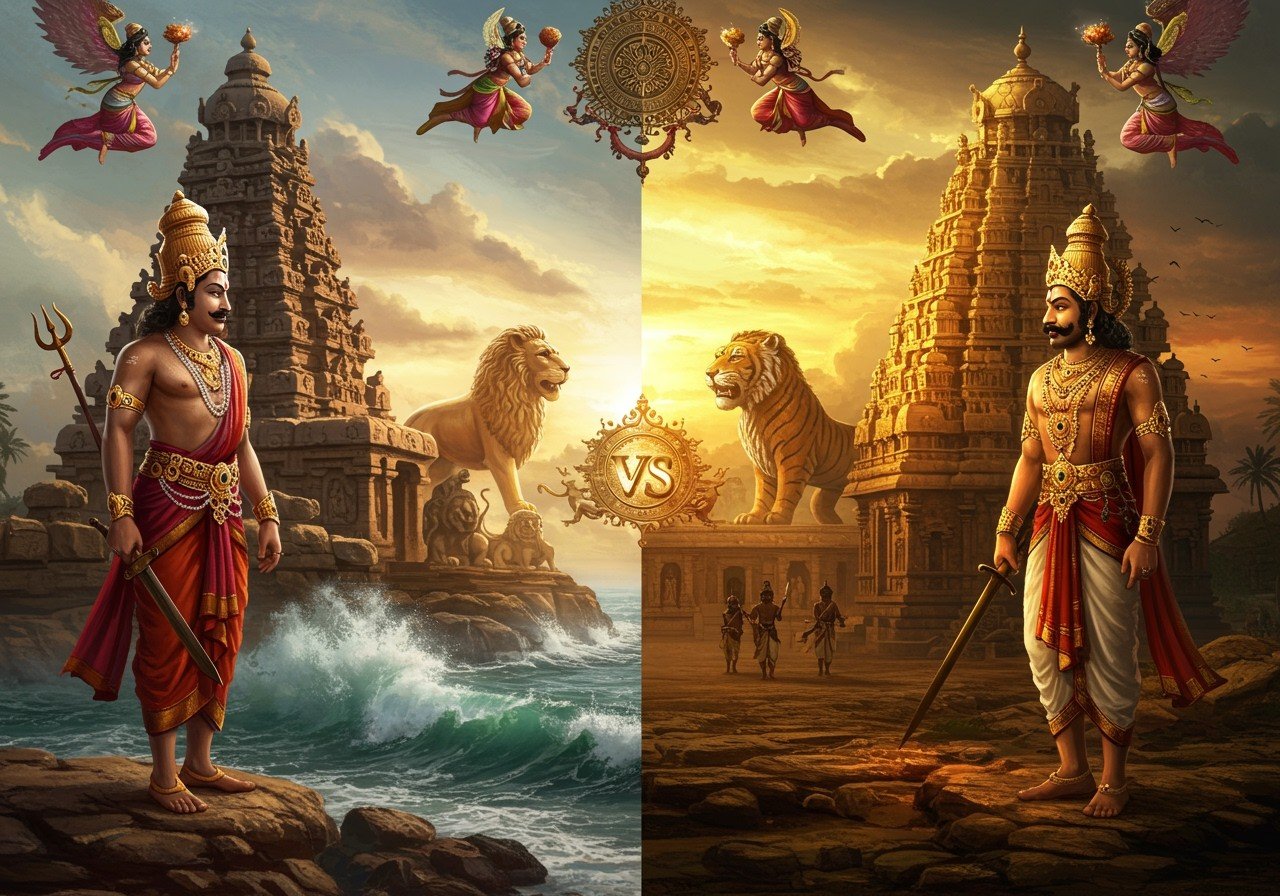
The Pallavas and Cholas, two of South India’s most influential dynasties, left an indelible mark on the region’s history and culture. This comparative study explores their origins, administrative systems, cultural contributions, and lasting legacies, offering a glimpse into the rich tapestry of South Indian civilization.
Origins and Rise to Power
The Pallava dynasty emerged in the 3rd century AD, establishing their capital at Kanchipuram. Early Pallava rulers, like Simhavishnu, expanded their territories and laid a strong foundation for future rulers. In contrast, the Chola dynasty, tracing its roots back to ancient Tamil kings mentioned in Sangam literature, re-emerged as a major power in the 9th century AD under Vijayalaya Chola. The distinct geographical and political landscapes surrounding each dynasty shaped their rise to dominance.
Administration and Governance
The Pallavas were renowned for their efficient administration and well-structured governance. Local self-governing bodies, known as ‘sabhas’ and ‘ur,’ played a crucial role in their political system. The Cholas, under Rajaraja Chola I and his successors, developed a highly sophisticated administrative system, evidenced by detailed inscriptions. Divisions like ‘nadu’ and ‘valanadu’ significantly impacted local governance. Both dynasties implemented effective strategies to manage their vast empires.
Cultural and Architectural Contributions
The Pallavas made significant contributions to Dravidian architecture, showcased in the magnificent rock-cut temples at Mahabalipuram. Masterpieces like the Shore Temple and Pancha Rathas stand as testaments to their architectural prowess. The Cholas elevated Dravidian architecture to new heights with grand temples such as the Brihadeeswarar Temple at Thanjavur, a UNESCO World Heritage site. They also championed bronze sculpture and other art forms. Both dynasties introduced unique styles and innovations, enriching South Indian art and architecture.
Dravidian and Nagara Architecture: A Comparison of Styles
Dravidian Temples: A Guide to Their Key Architectural Features
Religion and Philosophy
The Pallavas were patrons of both Shaivism and Vaishnavism, supporting religious scholars and institutions. Kings like Mahendravarman I actively promoted Shaivism. While the Cholas were devout Shaivites, they also extended their support to Buddhism and Jainism, demonstrating religious tolerance. Temples served as vital cultural centers under both dynasties, fostering religious and intellectual discourse.
Military Achievements and Expansion
The Pallavas maintained a formidable military, frequently engaging in conflicts with the Chalukyas. Battles like the Battle of Vatapi under Narasimhavarman I highlight their military strength. The Cholas, especially under Rajendra Chola I, expanded their empire to Southeast Asia, showcasing their naval dominance. These overseas conquests established vital trade routes and cemented their position as a major maritime power.
Literature and Education
The Pallavas were patrons of both Sanskrit and Tamil literature, transforming Kanchipuram into a renowned center of learning. Scholars like Dandin and Bharavi flourished during their reign. The Cholas also promoted Tamil literature, with works like the Thirukkural gaining prominence. They established educational institutions, and temples played a significant role in disseminating knowledge. Both dynasties nurtured intellectual and artistic pursuits, leaving behind a rich literary and educational heritage.
Conclusion
In summary, the Pallavas and Cholas were two extraordinary dynasties that profoundly shaped the course of South Indian history. The Pallavas set the stage with their administrative acumen, architectural innovations, and religious patronage. The Cholas, building upon this foundation, furthered these achievements with their vast empire, sophisticated governance, and cultural advancements. Both dynasties demonstrated exceptional military prowess, ensuring regional stability while engaging in significant battles and conquests. Their patronage of literature and education fostered a vibrant intellectual and artistic environment, leaving behind a lasting legacy of knowledge and creativity. Understanding these dynasties provides invaluable insights into the intricate tapestry of South Indian history and culture, reminding us of the enduring power of tradition, innovation, and the contributions of our ancestors.
Experience the Legacy with Poojn.in
Poojn.in, India’s leading online store for cultural and religious goods, offers a wide selection of products that connect you with the rich heritage of the Pallavas and Cholas. Enhance your spiritual practice and honor these great dynasties with our authentic collection:
- Temple Bells and Lamps: Discover traditional brass and bronze bells reminiscent of those used in ancient Pallava and Chola temples. Our collection also features beautiful deepa lamps in various sizes and traditional designs. Explore Our Temple Bells
- Ritual Items: Find authentic puja items like kumkum holders, vibhuti containers, and water vessels crafted in traditional South Indian styles, echoing the rituals practiced during the Pallava and Chola eras. Explore Our Ritual Items
- Bronze Statues: Explore our exquisite collection of bronze deities, meticulously crafted to reflect the iconic Chola bronze-making tradition. Bring home a piece of history and artistry. Browse Our Bronze Statues
- Temple Worship Essentials: We offer all the necessary items for traditional temple worship, including camphor holders, incense stands, and puja thalis, designed with classic South Indian motifs, connecting you to the rich heritage of these dynasties. Shop Temple Worship Essentials
Visit Poojn.in today to discover our complete range of authentic South Indian temple and puja items. We are committed to providing high-quality, genuine products with convenient doorstep delivery across India. Our offerings help you maintain traditional worship practices while honoring the artistic and cultural legacy of the Pallavas and Cholas.
Baijnath Temples: A Spiritual Journey, Pilgrimage, and Retreat


